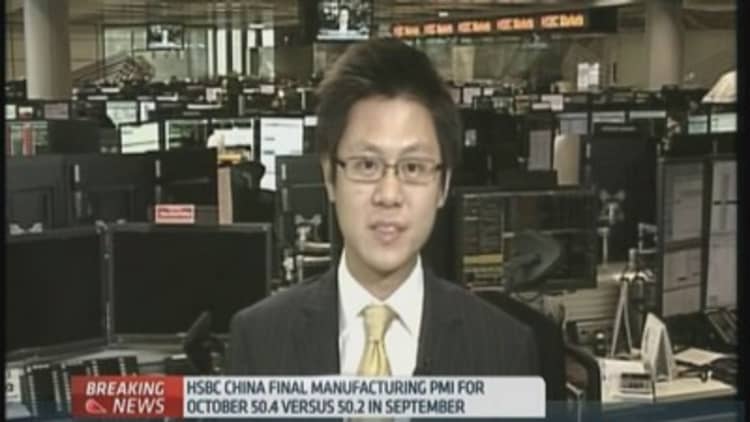A strong balance of payment history underpinned the Chinese yuan's strength this year, but recent data indicates that a reversal is underway.
China's external deficit in the third quarter – only its third this century – marks notably weaker fundamentals for the yuan and raises questions over its strength, Credit Agricole said in a report.
Last week, China's State Administration of Foreign Exchange (SAFE) reported a capital account deficit of $81.6 billion for the July-September period and a current account surplus of $81.5 billion.
Read MoreHas the yuan become a 'safe haven' trade?
"When you look at the numbers, the current account surplus was still smaller than the capital account deficit, so, technically speaking, that puts the third-quarter balance of payment in a deficit," Dariusz Kowalczyk, senior economist/strategist Asia ex-Japan at Credit Agricole, told CNBC.
Twin current and capital account surpluses were a key factor behind the yuan's over 2 percent rally against the greenback over the past six months, which defied broad dollar strength. The current account surplus hit $80.5 billion, while the capital account surplus totaled $77.8 billion in the first half of the year, SAFE data showed in September.
"Now in a very rare turn of events, this external surplus is disappearing and I think it will last for a while," Kowalczyk said.
Read MoreIs the yuan's recovery still intact?
Why is the trend shifting?
Credit Agricole attributes the capital account deficit to an unusually large outflow of capital, estimated at a record $125 billion.
"We suspect it is related to the foreign selling of real-estate assets, because the only other period of external deficit –Q2 and Q3 in 2012– also coincided with a downturn in housing prices," Credit Agricole said in a report.
Read MoreIs a new currency war about to start?
China's property market, which accounts for roughly 15 percent of the economy, slumped this year, with average home prices posting their fifth straight monthly fall in September.
"We think that the downward trajectory in home prices as well as in the pace of economic activity will last until Q1 of 2015, which suggests more scope for capital outflows," the report said.
Outflows are also coming from deposits as Chinese corporates and individuals diversify their savings, Khoon Goh, senior FX strategist at ANZ added, noting Chinese banks have also started to increase overseas lending.

Yuan weakness ahead?
The near-term outlook for China's external balance may be negative, but this doesn't necessarily translate into yuan depreciation, according to Credit Agricole. In fact, the bank points out that the yuan actually appreciated during two out of the three quarters China had a deficit on its external position.
"This can be explained by market expectations of further appreciation, which could lead to larger price moves for every dollar sold than bought," it said.
ANZ's Goh expects yuan appreciation to continue on the back of strong investor demand for onshore Chinese assets.
Read MoreEMs cheaper but not necessarily better
"Looking at the third-quarter, the People's Bank of China (PBOC) was largely absent in the FX market, which saw FX reserves turn minimal. Yet, the currency continued to appreciate, indicating strong demand," he said.
On Monday, the currency weakened to 6.117 against the dollar after strengthening to 6.1072 on Friday, its highest level since early March.

